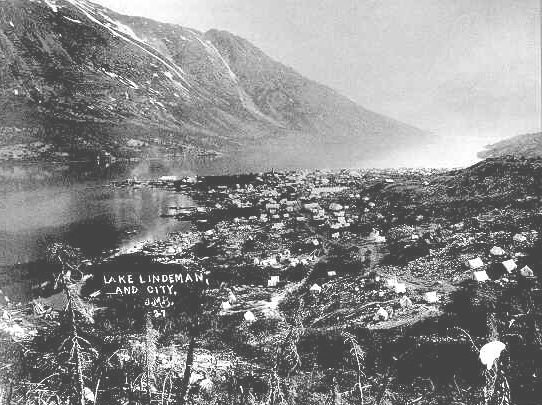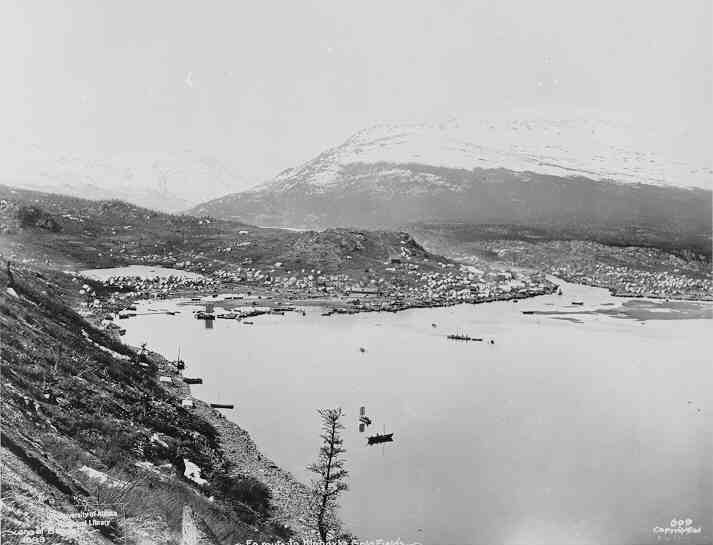
Photo courtesy of Special Collections Division, University of Washington Libraries, Goetzman 609
Klondike stampeders set up camp along the shores of Lake Lindeman and Lake Bennett during the winter of 1897-1898. These men, women and children had managed to drag and carry tons of provisions over the harsh trails down to the lakes, which formed the headwaters of the Yukon River. The crowd had to wait for the river ice to break before they could sail down the Yukon into Dawson. Some stampeders stayed at Lake Lindeman, the end of the Chilkoot Pass, many more kept moving down the trail and set up camp at Lake Bennett, which was also the terminus of the White Pass trail.
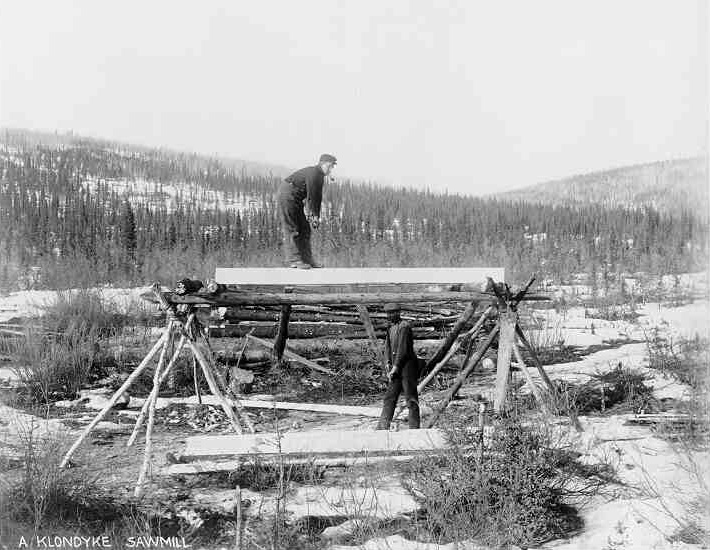
Photo courtesy of Special Collections Division, University of Washington Libraries
Most stampeders needed to build their own boats, having declined to drag a boat over the pass. The preferred wood cutting technique, known as "whipsawing," led to more than a few disagreements and fights. Logs placed on stands were sawed by one man standing on top of the log with one end of the saw and a second man standing below the log holding the other end. The work was so hard, that no matter which position he took, it was easy to for each man to believe that he was doing all the work.
The effect of thousands of campers living for months along the lakes is still clearly visible a century later. Desperate for lumber to use for boats and firewood, stampeders deforested the areas around the two lakes.
"Knock-down boats of every conceivable sort are being taken up since the reports have come down that boat timber is very scarce, as well as high in price. . . . Reports are discouraging about [carrying] boats. The trails up the mountains are reported so narrow and tortuous that long pieces cannot be carried over. In that case [mine] may never get over. Hundreds of boats, it is said, are left behind."
Tappan Adney, journalist The Klondike Stampede, 1900
August 24-29, 1897
"Reached the foot of Long Lake, three miles from Lindeman, at four o'clock. Quite a number of tents here. . . . Arrived at Lake Lindeman at seven o'clock. The camp at the head of the lake contains about 50 tents and a temporary population of 200. . . . Left at 11:00 a.m. for Lake Bennett in Peterboro canoe. Outfit of entire party, weighing four thousand pounds, was ferried to the foot of Lake Lindeman, six miles, for $30.The lake is a beautiful sheet of water, about six miles long and one mile wide. It empties into Lake Bennett through a very crooked and narrow stream, full of rocks and rapids, and dangerous for boats. It is necessary to make a portage of three-quarters of a mile to the head of Lake Bennett, boats being let down through the swift stream by means of rope."
Taken from Sam C. Dunham's report on the Alaskan gold fields for the U.S. Department of Labor, 1897.
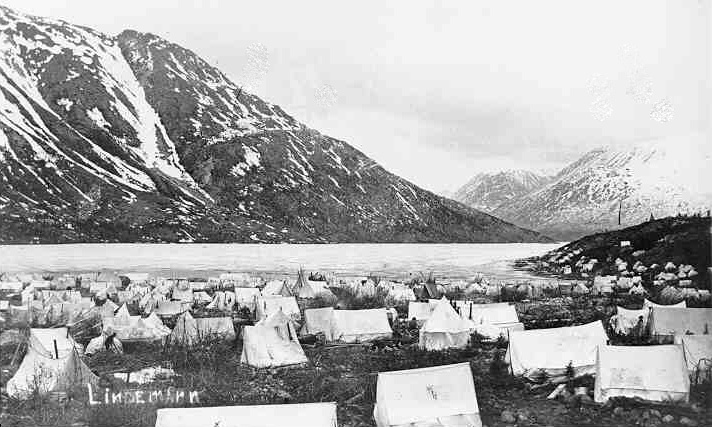
Photo courtesy of Special Collections Division, University of Washington Libraries, Cantwell 42
Lake Lindeman was the terminus of the Chilkoot Pass trail. Many stampeders, exhausted after dragging a ton of supplies over the pass, chose to camp by the side of Lake Lindeman to wait out the winter. When one traveler, Julius Price, who crossed the Chilkoot Pass in 1898, first saw the tent city growing up along the shores of Lake Lindeman, he noted that the vast spread of white tents looked "like a flock of seagulls on a distant beach." By the end of September 1897, hundreds of men and women were in Lindeman, busy building boats for the journey down the Yukon. Their numbers grew to over 1,000 by the end of the year. When the Yukon River began to thaw in late May, over 4,000 people were camped out along Lake Lindeman.
May 16, 1898 "This letter of yours is the first and only one I have received from anyone since we left Seattle. . . . Oh if you could only see the boats that are being built here thousands of them. There must be some hundreds in this cove alone.""
George Musgrove, in a letter to his friend Russell Hazard. From the collections of the University of Alaska, Anchorage.
Mail was critical to stampeder morale during the winter of 1897/1898. Stuck in tents stretched out along Lake Lindeman and Lake Bennett, these thousands of men and women had little to occupy their time and longed for word from home. For a time, U.S. mail was only carried as far north as Sheep Camp, along the Chilkoot Pass trail. Private, unofficial mail carriers made some money ferrying letters between Sheep Camp and the tent lake cities.
April 20, 1898 "Got your letter on Thursday last. The P.O. delivers our mail to Sheep Camp, from there a private carrier brings it to Lake Linderman [sic] for which we pay 15¢ per letter, and am glad to get them at that price. . . . Tonight we are camped on the ice on Linderman [sic] having brought down two sled loads from the summit. The camp is full, some people have been here all winter. We will have to go a mile or so down the lake shore to find a place to pitch our tent."
Harley Tuch, from a diary he kept for his wife on his journey to the gold fields.
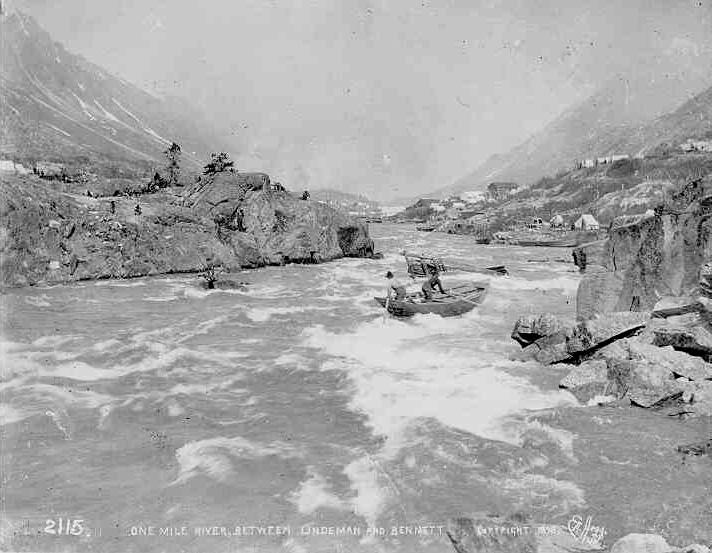
Photo courtesy of Special Collections Division, Washington Libraries, Hegg 2115b
Many who stayed at Lake Lindeman regretted their decision in the spring. Ice and snow hid the wild rapids between Lake Lindeman and Lake Bennett. What would have been a tedious, but safe journey in the winter was a short but dangerous navigation through churning rapids in the spring.
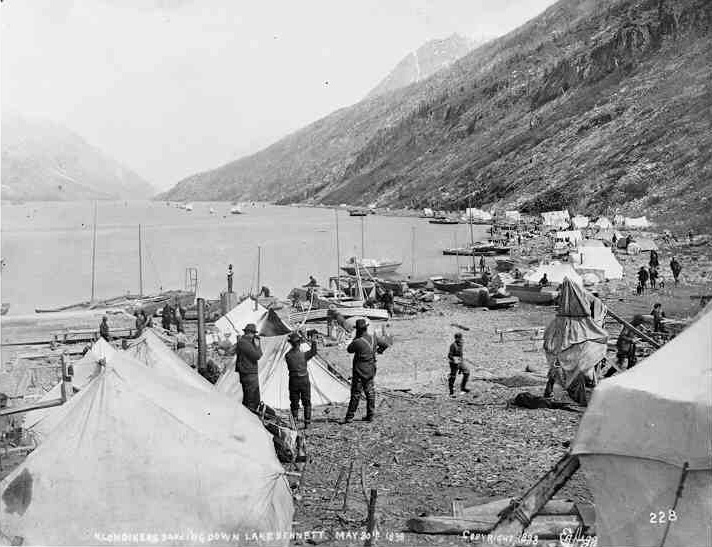
Photo courtesy of Special Collections Division, Washington Libraries
Lake Bennett was the end of the White Pass trail. Stampeders who had passed over the mountains from Skagway during 1897 spent the winter camped along the lake shore. They were joined by thousands who had crossed over the Chilkoot Pass and continued down to Bennett before stopping to camp, waiting for the spring thaw.
Lake Bennett, April 21, 1898
"I sent a letter off this morning by a man from Massachusetts who was going to Dyea. I went up to Lindeman to look for mail but was disappointed. My walk was about 33 miles today, 16 of those for a letter that did not come. . . . I will try to get some more letters out to you. Lord knows whether I shall get any or not. There are three different men supposedly bringing mail from Dyea but it is badly muddled somehow and nobody seems to get any."Alfred G. McMichael, from a letter home written at Lake Bennett April 21, 1898. "Klondike Letters: The Correspondence of a Gold Seeker in 1898," edited by Juliette C. Reinicker.

Photo courtesy of Special Collections Division, Washington Libraries, Hegg 65
The most pressing activity of all who arrived at the tent cities along the lakes was boat building. Few experienced boat builders were among the thousands of clerks, farmers, and workers who crowded the shores along the headwaters of the Yukon. They learned from watching, doing and their own mistakes.
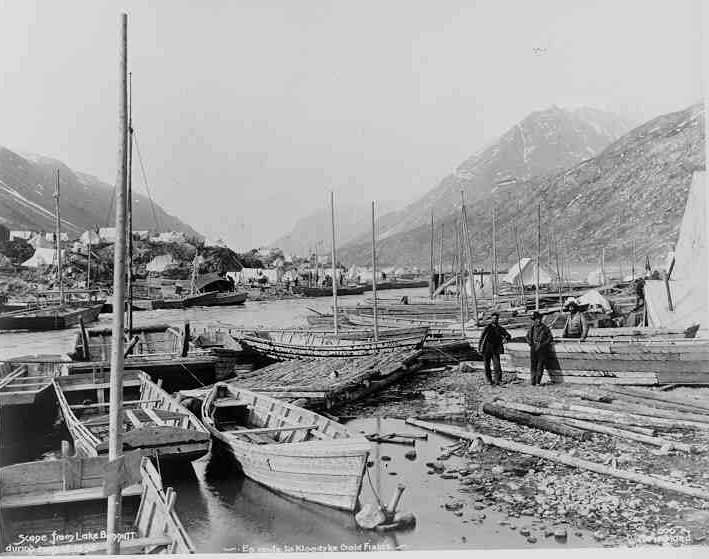
Photo courtesy of Special Collections Division, Washington Libraries, Hegg 65
At long last, after months of waiting for many, the ice covering the Yukon River began to break up. Rumors about the conditions of the ice flew through the tent cities at Bennett and Lindeman. Some stampeders, thinking that the river was clear, set out too early and got stuck in ice jams.
By the end of May, the river had broken up enough for traffic to begin. Hundreds of boats began leaving the lakes each day. Those who had arrived late or procrastinated with building their boats worked at a now frantic pace, afraid that they would now be the last into the gold fields. The overall mood of the stampeders was one of excitement and adventure. After months of dragging their goods over the passes, they could now just sail smoothly down the Yukon into Dawson. Of course, those who had done their research knew that the trip downriver held its own dangers—including the White Horse Rapids.

